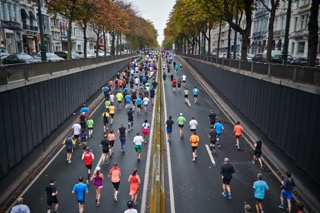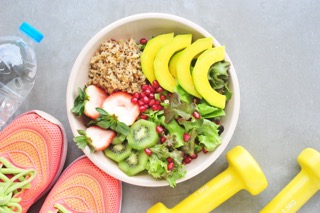Cover Your Bases
In the first article of this series, we set the foundation by discussing optimal nutrition for your training days. Now we will review the latest sport nutrition guidelines to help you fuel your training while staying healthy and energized for your upcoming race.
• We will explore the following topics:
• Your energy needs and why it is critical to meet them
• Balancing your macronutrients (carbohydrates, proteins, and fats)
• How macros impact your training and performance
• Tips to help you get your hydration right
• Benefits of periodizing your nutrition for your training
Meet Your Energy Needs
Energy availability is an essential foundation for optimal health and exercise performance.1,2 As you begin a lengthy training period, make sure that your dietary intake meets your energy requirements.
Energy deficiency during training can have negative physical and psychological consequences (e.g., fat-free mass, illness, poor sleep, delayed recovery, hormonal imbalance, elevated resting heart rate, apathy towards training, or increased stress). Any combination of these factors can compromise your training, your performance, and your health over time. If you want to optimize your training and performance, be sure to consume enough calories to offset your energy expenditure.3
Energy balance occurs when the total Energy Intake (EI) you obtain from food and fluids equals your Total Energy Expenditure (TEE), which consists of the following:
•Your Basal Metabolic Rate (BMR): the energy required to support your life-sustaining activities, such as breathing, circulation, and cell production
•The Thermic Effect of Food (TEF): the energy used to digest, absorb, metabolize, and store food — which can vary from 3 to 10% of the energy expenditure depending on the types of food eaten
•The Thermic Effect of Activity (TEA): the energy burned during all physical activity, from simple fidgeting to the most strenuous workouts
TEE = BMR + TEF + TEA1
In the general population, the BMR accounts for about 2/3 of the TEE, but it may only be 1/3 for elite endurance athletes who can have a TEA as high as 1/2 of the TEE. While your training volume and intensity may not be as high as an elite athlete’s, it still matters. Adjust your energy intake to meet your energy balance based on your training load.1,4,5
According to the latest sports nutrition guidelines published by the International Society of Sports Nutrition (ISSN), if you exercise for 30–40 minutes three times a week, a regular diet of about 1800–2400 kcals/day (or 25–35 kcals/kg/day for a 50–80 kg individual) should meet your nutritional demands. However, if your training is more intense (2–3 hours of intense exercise per day, 5–6 days per week, or even higher volumes, such as 3–6 hours of intense training in 1 or 2 workouts, 5–6 days per week), you may expend 600–1200 kcals or more per hour during exercise. This level of effort gives you a caloric need of 2000–7000 kcals/day (or 40–70 kcals/kg/day for a 50–100 kg athlete), and your food intake should cover the additional energy expenditure.3
To put things in perspective and better understand how your macronutrient strategy impacts your daily dietary needs, carbohydrates and proteins have 4 kcal per gram, while fat has 9 kcal per gram. Now that we have established that your dietary intake must match your energy needs, let’s examine what foods provide the nutrition to best support your activity.
Get Your Macronutrients Right
As an endurance athlete, consuming an optimal macronutrient ratio can help you reach your training goals: performance, muscle gain, or fat loss. Depending on your sport, the timing of your nutrient intake throughout the day is as important to your training and recovery as what you eat.1
That said, the quality of your food is an important factor to consider. We recommend consuming whole foods over packaged foods whenever possible. Eating a clean, nutrient-dense diet that includes a wide variety of foods rich in antioxidants, fiber, vitamins, and minerals should provide all the nutritional fuel you need to sustain your exercise and stay healthy.4
Let’s take a closer look at the macronutrients (carbohydrates, proteins, fats) and explore how consuming the recommended quantities at the correct times can help you achieve your performance goals.
Carbohydrates
Carbohydrates are a primary energy source for our brain and our central nervous system, and they form a versatile substrate for our muscular work.1 The beneficial effects of carbs on athletic performance are well-known and supported by over 60 years of research.
Carbs are useful for long periods of high-intensity exercise.
Fat and carbs are used as fuel when exercising at lower or moderate intensity (65% VO2max). As intensity increases (85% VO2max), carbs become the primary energy substrate. During aerobic exercises, in the presence of oxygen, carbs will produce less ATP (the energy currency of our cells) than fat: 30-32 ATP for one glucose molecule versus hundreds of ATP depending on the fatty acid length. However, ATP will be produced much faster from carbs than fat. Furthermore, when engaging in extremely high-intensity anaerobic exercises, glucose is the only substrate that will supply energy without using oxygen, generating only 2 ATP in the absence of oxygen — but generating them hundreds of times faster than fat oxidation. As the substrate of choice for high intensity, carbs are essential to achieve speed and performance.
Carb storage is limited in our body and requires sufficient intake to avoid depletion. When ingested, carbs are broken down to glucose and stored as glycogen in our liver and muscle. Glycogen stores are limited and rapidly depleted during long and strenuous exercise.
Glycogen depletion is an important limiting factor of performance. It is associated with fatigue and reduced work rates. At the same time, inadequate carbohydrate intake increases the perception of effort, hinders the central nervous system, and impairs performance-influencing factors such as pacing, motor skill, and concentration.
Adequate intake before, during, and after long periods of high-intensity exercise — including race day competitions — is vital to performance and recovery.3,6 As you progress in your training plan and increase your mileage, you should purposefully eat more carbs while adjusting your daily intake based on each day’s training. Carb intake should be higher on hard training days and less on easy days. The current sport nutrition guidelines recommend a daily intake of:
• 3-5 g per kg of body weight for light activity
• 5-7 g per kg of body weight for moderate exercise (~1 h/day)
• 6-10 g per kg of body weight for vigorous exercise (1-3 h/day)
• 8-12 g per kg of body weight for very high training (>4 h/day)1,2,3,4
As you plan your carbohydrates, remember that not all carbs are created equal. They can be divided into two categories: simple carbs and complex carbs.
Simple carbs are sugars and refined grains that have been stripped of their fiber and nutrients. Omnipresent in the western diet, they are commonly found in processed foods such as soda, baked goods, fruit juice, or breakfast cereals. They are easy to digest and lead to rapid blood sugar and insulin spikes, which have been linked to an increased risk of chronic diseases, including obesity, heart disease, and type 2 diabetes.
Complex carbs include fruits, vegetables, whole grains, and legumes. They are packed with nutrients and fiber and digest more slowly than simple carbs. They are also known for their long-term health benefits as they can help maintain a healthy weight and guard against type 2 diabetes and cardiovascular problems.
As an endurance athlete, you can support your general health by eating nutrient-rich, unrefined carbs like colorful fruits and vegetables, whole grains (oats, quinoa, or brown rice), and legumes (beans, lentils, or peas). However, there is still a place for simple carbs in your training nutrition plan. They will release energy more quickly, allowing you to improve performance, delay fatigue, boost concentration, and decrease perceived exertion. Still, they should be consumed primarily for long (> 90 minutes) or strenuous sessions.
Since they are easy to digest, simple carbohydrates can come in handy as a pre-exercise snack — especially if you don’t have enough time to allow digestion before a long or strenuous workout. Bananas, rice cakes, white bread, dried fruits, juices, or energy bars can be good options for a quick burst of energy.
During your training or competition, sports drinks, gels, or energy bars will provide simple carbs that maintain blood glucose levels, provide extra fuel, and spare glycogen stores. The more intense the exercise, the more carbs you need. Recreational endurance athletes should try to consume 30g of carbs per hour for low- to moderate-intensity training, increasing up to 60g per hour for high-intensity sessions. Remember that there is no need to eat anything for shorter and slow-paced sessions (less than 60-90 minutes), as your glycogen stores will be sufficient to fuel those training sessions.
In addition to fueling you before and during your workout, simple carbs can also help restore your glycogen stores rapidly if you have a short recovery window between sessions. However, if you have time post-training, you should favor complex carbs, such as whole-grain bread, whole-grain pasta, whole grains, beans, lentils, or starchy vegetables. These will replenish your glycogen stores and add healthy nutrients, fiber, and protein to your diet. Simple carbs are great for quick energy, but you should always favor real food outside your workouts.
Macronutrient and Fluid Intake Recommendations For Endurance Training, Event Fueling, and Recovery 
Figure 1 – Macronutrient and Fluid Intake Recommendations For Endurance Training, Event Fueling, and Recovery
Proteins
Proteins and their base components, amino acids, are essential for various bodily functions. They make enzymes, hormones, and neurotransmitters and build and repair muscles, tendons, and other soft tissues. Muscle proteins break down during exercise, and protein in the diet provides the amino acids essential for repairing and regenerating damaged proteins in the muscle. As a result, endurance athletes may require a higher protein intake than the average person to prevent muscle loss and reduction in muscle strength. The current guidelines suggest that an athlete should ingest between 1.4-2.0 g of protein per kilogram of body weight per day (an average of 75-120 g per day for a 50-80 kg individual), with higher amounts during heavy training volumes to maintain energy balance, protein balance, and muscle mass. Protein requirements also increase with age (as muscle in individuals over 53 years may be slower to respond and less sensitive to protein ingestion),3 and for those trying to lose body fat while maintaining or increasing fat-free mass. Overall, protein sources should account for about 15-30% of an endurance athlete’s total calorie intake.4
Studies have reported better results when spreading high-quality protein intake throughout the day (0.3 g per kg, or 15-25 g every 3 to 5 hours). They have also shown that consuming 30-40 g of casein protein before sleep can increase muscle protein synthesis.2,4,7
During strenuous endurance exercises that last longer than an hour, we recommend consuming 0.25 g of protein per kg of body weight per hour in addition to the standard 30 to 60 g of carbohydrates. This combination has been shown to suppress markers of muscle damage and reduce feelings of muscle soreness.2,7
While carbohydrates and fats are the predominant energy sources for training, protein can also provide fuel. When muscle breaks down during exercise, it releases amino acids that can be converted to glucose in the liver or directly oxidized within the mitochondria of the muscle cells to provide fuel. Adequate carbohydrate and fat consumption allows your protein intake to be directed towards repair and synthesis rather than being used as an energy source.2,4,7
If you want to maximize your amino acid availability and cover all your other nutritional needs, try to obtain your protein from various whole food sources whenever possible. Good options include meat, fish, dairy, eggs, legumes (lentils, peas, beans), grains, nuts, seeds, and soy products (preferably fermented, such as tempeh, miso, natto, or minimally processed soybeans or edamame). However, the amount of protein available in those different foods varies, as does the protein’s bioavailability (the measure of the body’s ability to digest and absorb the protein content).
The best protein sources are those rich in essential amino acids, especially leucine, which are critical for achieving maximal rates of muscle protein synthesis (MPS). Animal sources are high in leucine and contain the nine essential amino acids our body needs to obtain from the diet. Plant sources, while beneficial, may be deficient in one or more of these essential amino acids or contain them in insufficient amounts. Therefore, if you follow a plant-based diet, you should combine complementary plant proteins (e.g., rice with lentils or beans) and increase your portion sizes to obtain your daily protein requirements.
High-quality protein powders are suitable (and convenient) alternatives for meeting your protein needs. A protein shake that combines protein powder with fruits, oats, veggies, nuts, seeds, dairy, or plant-based milk can make a great recovery drink after a training session. Whey protein is rapidly digested, making it an excellent option for quick recovery between training sessions. Casein protein is slower-releasing, which is why it can be taken before bed if you want to increase MPS overnight. Vegan protein powders are also available, most including soy or a combination of pea and rice that covers all the essential amino acids.4,7
Fats
Sport nutrition guidelines recommend 20% to 35% — and no less than 15% — of your daily calories come from healthy fats. The rationale for this direction comes from the fact that fats are essential for many processes in the body, including cell membrane structure, absorption of fat-soluble vitamins, hormone regulation, brain health, and energy for muscle metabolism.
Healthy fat sources include fish (salmon, mackerel, or sardines), avocado, nuts, seeds, coconut oil, extra virgin olive oil, full-fat yogurt, or cheese. All these are high in Omega 3 fatty acids, which help endurance athletes counteract inflammation and free radical formation caused by training.4
These days, we see an increased interest in low-carb/high-fat and ketogenic diets among endurance athletes. Most use these diets to change their metabolism and improve their body’s ability to use fat as fuel at higher intensities, reducing the need for carbohydrates. These approaches can benefit those embarking on long-distance events that do not require high-intensity effort. They can also help athletes suffering from gastrointestinal distress as they can reduce carb intake during training and competitions. Other potential benefits include weight loss, improved body composition, delayed onset of muscle soreness, decreased inflammation, attenuated exercise-induced oxidative stress, improved cognition and mood, and reduced fasting glucose and insulin levels.
That’s not to say these diets are without their concerns. First, engaging in high-intensity training in a low glycogen state will be difficult because, at a certain degree of intensity, your body will fully rely on carbohydrates to produce energy. Second, research has shown that if you don’t train with high carbs at times, you may lose your ability to efficiently convert carbohydrates to energy, compromising your performance at higher intensities. Finally, when it comes to energy production, fat oxidation requires a higher volume of oxygen than carb oxidation, which makes it less economical and reduces the beneficial impact of an increased VO2max.8
Furthermore, such diets may cause increased satiety and reduced energy intake, which is useful for weight loss but potentially detrimental for highly active athletes who need enough caloric intake to fuel their exercise. Also, high-fat diets often reduce fiber and micronutrients (including iron, magnesium, potassium, folate, and antioxidants), which can harm the gut microbiome and iron metabolism.9,10
While these popular diets can be helpful for those looking to lose weight or regulate issues with blood sugar and insulin function, there is not enough current evidence to support their long-term use. During base training, a short-term low-carb/high-fat diet can improve fat utilization, endurance capacity, and body composition. However, as the season progresses, you should increase your carb intake to enhance the glycolytic energy pathways needed during high-intensity competitions.
Hydration
Proper hydration is essential for endurance athletes who want to maximize their thermoregulation and exercise performance.
When you exercise, it’s natural to lose water weight through perspiration and respiration. With this in mind, your exercise-induced weight loss should not exceed 2% of your body weight; otherwise, your cognitive function and performance may be impaired. To keep this from happening, you should follow a proper hydration strategy before, during, and after exercise based on your specific needs and fluid losses.
Hydration needs vary from one person to the other due to differences in fluid and electrolyte loss. To determine whether you are drinking enough fluids, you can monitor your urine color (it should be pale yellow) or weigh yourself before and after exercise. Whatever method you use is far better than simply waiting until you feel thirsty. When you’re training or competing — especially at high-intensity levels — you may have already lost too much fluid through sweat before you feel thirsty.
Sweat is composed of water and electrolytes (sodium, potassium, calcium, magnesium, and chloride), all of which are vital for top performance. To replenish the water and electrolytes you lose during exercise, drink fluids combined with electrolytes or add a little extra salt to your diet. For a summary of pre-, mid-, and post-race fluid intake, see Figure 1 above.
Periodized Nutrition
While current guidelines do not recommend a low-carb/high-fat approach for endurance athletes, they are more nuanced than in the past and do not suggest constant high-carb fueling either.1,11 Instead, endurance athletes are advised to periodize their dietary intake based on their training goals and race schedules to maximize exercise performance and recovery.2
As an endurance athlete, you are used to periodizing your training to maximize your performance. Your coach will break down your training season into different phases and systematically alter your sessions throughout the year, manipulating your intensity, types of exercise, duration, or frequency to obtain specific training outcomes. Periodized nutrition is a relatively new concept that uses nutritional interventions purposefully and strategically to amplify those training adaptations by targeting either a training phase or a specific session.12
Practically speaking, your training season should be broken down into training phases. Your base training typically consists of low-intensity workouts that can be fueled by fat, as they won’t require high energy intake. As a result, you won’t need as many carbs or additional energy intake during this phase. Simply consuming fewer carbs — especially refined, starchy, and sugary ones — while keeping your regular intake of protein, healthy fats, and nutrient-rich fruits and vegetables should support your performance. You may even improve fat utilization, endurance capacity, and body composition by following a low-carb/high-fat diet.
As the season progresses, higher carb intake is necessary to improve the glycolytic energy pathways needed for higher-intensity efforts. You will have more vigorous exercises that will burn more calories during build and peak phases, so we recommend increasing your carb intake throughout the season. Beyond just the carbs, your total calories should align with your training volume to meet your energy balance.2
Dialing in your nutrition strategy even further, you should adjust your dietary intake around each workout to match the demands and goals of specific training sessions. You want to increase your carb intake for high-intensity sessions or when you want to perform well. Conversely, you should limit your carb intake for lower-intensity sessions or when you want to trigger training adaptations.
Because carbs are key in regulating muscle and metabolic responses to exercise, playing with your carb intake for a specific session can trigger targeted adaptations that improve your sports performance and metabolic flexibility (i.e., the ability to switch between fat and carbs as fuel sources). This practice, known as carb periodization, is the topic of our next blog. So if you’d like to dive deeper and understand how carb periodization works and how it can improve your metabolic flexibility and positively impact your overall health and performance, join me in our next blog!
Conclusion
Now that you have a better grasp on what your diet should look like during your training days, it’s time to step back and think about your dietary plan and how you could best apply those nutrition guidelines. The summary table above (Figure 1) can be a great tool to help you define your diet plan, so feel free to download or print it for easy reference.
Creating a personal nutrition plan based on general guidelines can be cumbersome, and we are here to assist. If you feel overwhelmed, don’t know where to start, or just need some guidance, please reach out! We can help you define your personalized diet plan based on your training, lifestyle, and preferences. We’ll work with you to ensure you can train efficiently and perform your best on race day.
References
- Thomas DT, Erdman KA, Burke LM. American College of Sports Medicine joint position statement. Nutrition and athletic performance. Med Sci Sports Exerc. 2016;48(3):543-568.
- Casazza GA, Tovar AP, Richardson CE, Cortez AN, Davis BA. Energy availability, macronutrient intake, and nutritional supplementation for improving exercise performance in endurance athletes. Curr Sports Med Rep. 2018;17(6):215-223.
- Kerksick CM, Wilborn CD, Roberts MD, et al. ISSN exercise & sports nutrition review update: research & recommendations. Journal of the International Society of Sports Nutrition. 2018;15(1).
- Bytomski JR. Fueling for Performance. Sports Health. 2018;10(1):47-53.
- Heydenreich J, Kayser B, Schutz Y, Melzer K. Total Energy Expenditure, Energy Intake, and Body Composition in Endurance Athletes Across the Training Season: A Systematic Review. Sports Med Open. 2017;3(1):8.
- Hearris M, Hammond K, Fell J, Morton J. Regulation of Muscle Glycogen Metabolism during Exercise: Implications for Endurance Performance and Training Adaptations. Nutrients. 2018;10(3):298.
- Jäger R, Kerksick CM, Campbell BI, et al. International Society of Sports Nutrition Position Stand: protein and exercise. J Int Soc Sports Nutr. 2017;14:20.
- Burke LM, Hawley JA, Jeukendrup A, Morton JP, Stellingwerff T, Maughan RJ. Toward a Common Understanding of Diet–Exercise Strategies to Manipulate Fuel Availability for Training and Competition Preparation in Endurance Sport. International Journal of Sport Nutrition and Exercise Metabolism. 2018;28(5):451-463.
- Bailey CP, Hennessy E. A review of the ketogenic diet for endurance athletes: performance enhancer or placebo effect? Journal of the International Society of Sports Nutrition. 2020;17(1). doi:10.1186/s12970-020-00362-9
- McSwiney FT, Doyle L, Plews DJ, Zinn C. Impact Of Ketogenic Diet On Athletes: Current Insights. Open access journal of sports medicine. 2019;10:171-183.
- Fritzen AM, Lundsgaard A-M, Kiens B. Dietary Fuels in Athletic Performance. Annual Review of Nutrition. 2019;39(1):45-73. doi:10.1146/annurev-nutr-082018-124337
- Jeukendrup AE. Periodized Nutrition for Athletes. Sports medicine (Auckland, NZ). 2017;47(Suppl 1):51-63. doi:10.1007/s40279-017-0694-2












